Matchday one of the 2024/25 UEFA Champions League is complete and it was a whirlwind of action and surprises.
Our tactical analysis shares the best tactical formations and plays from Champions League week one, as we dive into what worked and what didn’t work.
Let’s start off with a look at Juventus’ 3-1 win over PSV Eindhoven.
Juventus 3-1 PSV Eindhoven
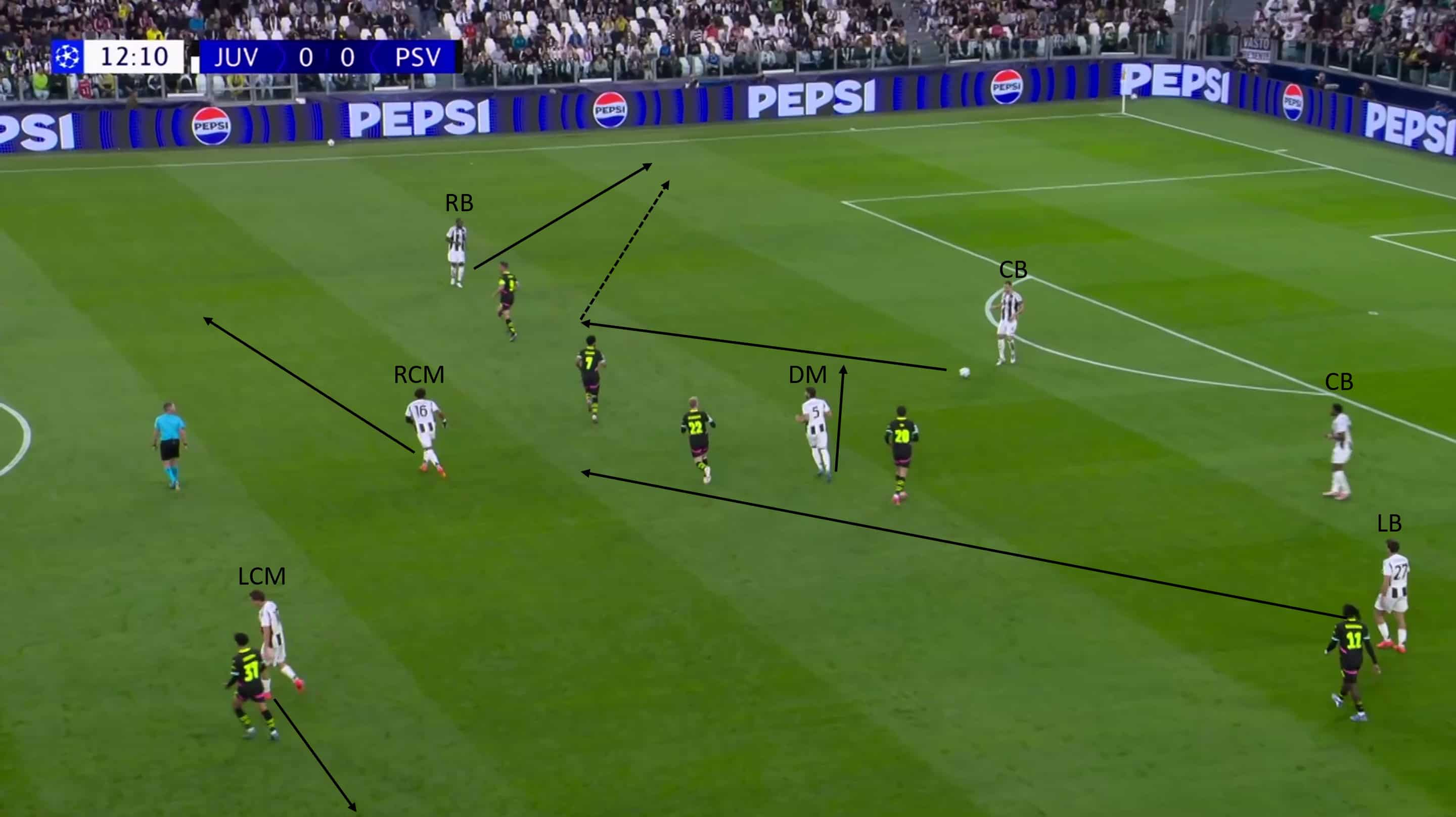
Thiago Motta moved to the Old Lady in the summer from Bologna, with whom he qualified for the UCL.
It is not without reason that there is a new, young, up-and-coming generation of coaches with a slightly different style of play.
The build-up play of Xabi Alonso, Fabian Hürzeler and Thiago Motta is a lot of fun to watch.
Relationism involves many changes in position, overloads, and less fixed structures.
The graphics show Juve’s build-up play in the 13th minute.
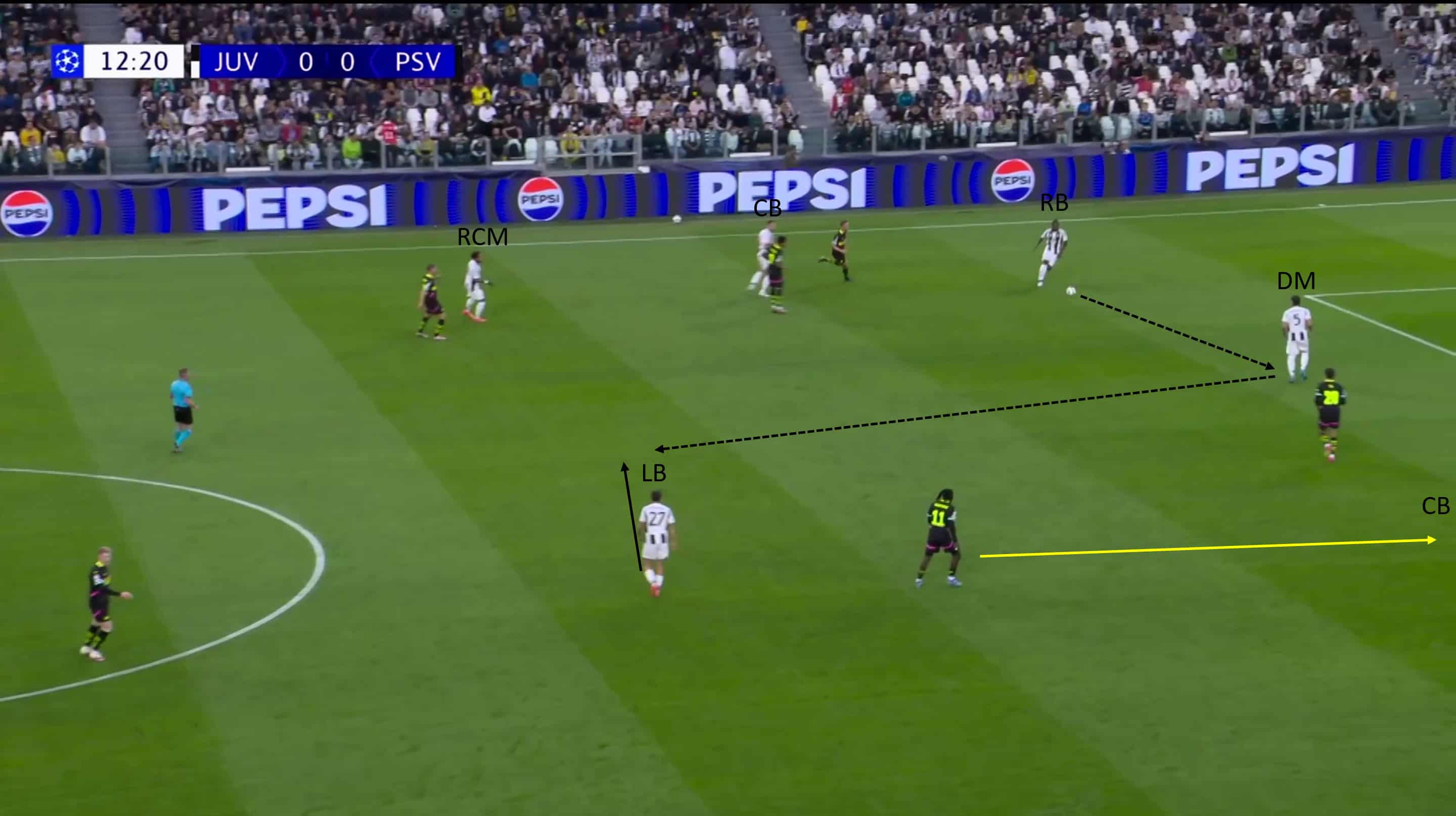
Juventus use several positional rotations to bypass PSV’s pressing.
The full-back on the far side tucks inside as the ball-carrying centre-back drives forward, while the near-side full-back drops back to receive the ball and passes to the dropping ‘number 6’.
The ‘6’ can then play it to the now free, tucked-in full-back in the centre.
This is a typically relationist play, mainly based on individual and small-group tactical principles in overload situations, such as dribbling towards opponents to engage them and creating multiple vertical layers.
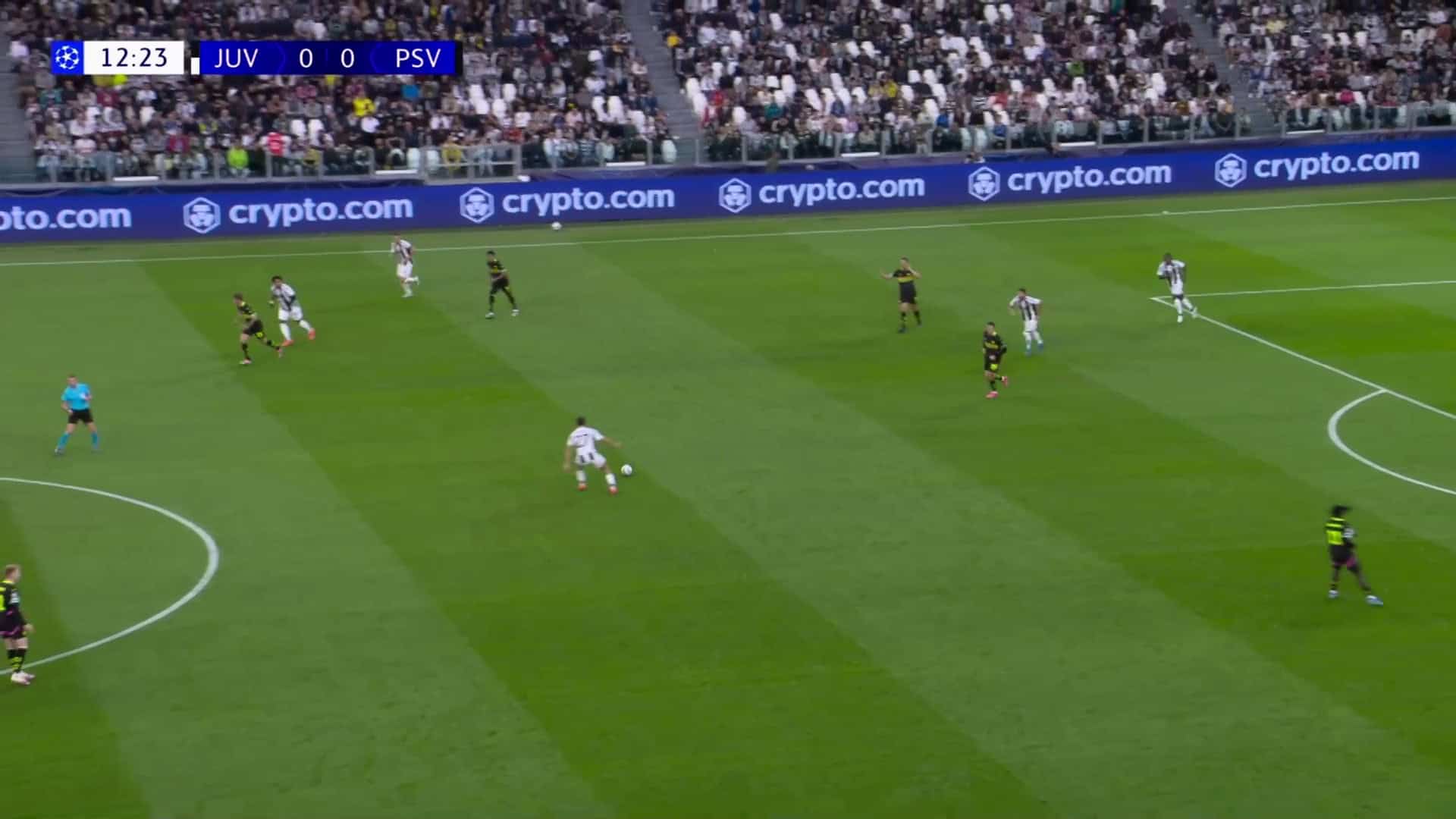
You can see plenty of examples of plays like this from Fluminense under Fernando Diniz — considered the father of relationism.
Real Madrid 3-1 Stuttgart
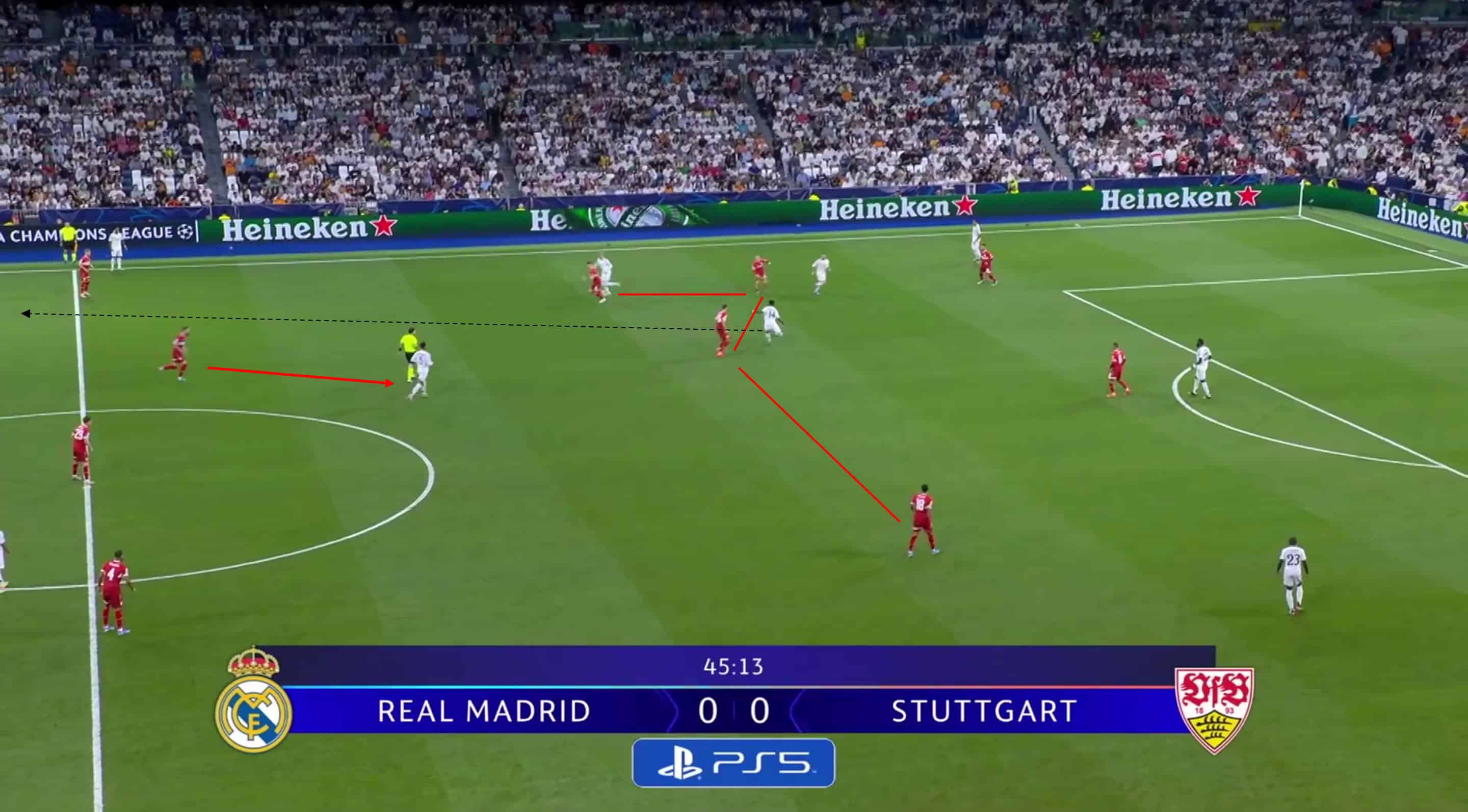
Real Madrid’s first goal comes from the first play after kick-off.
The principle: lure and shock (from the German: ‘locken und schocken’).
Stuttgart repeatedly press high in a 4-4-2 formation, with their backline pushing up to the halfway line.
Real Madrid play through their centre-backs and full-backs into the middle of the park, luring Stuttgart into their attacking press.
Jude Bellingham positions himself near the ball-side centre-back Jeff Chabot, pulling him out of the defensive line, leaving no cover for the ensuing deep ball to Rodrygo.
This is likely a tactic discussed at halftime, aiming to exploit Stuttgart’s attacking press using the speed advantage of Kylian Mbappé, Rodrygo, and Vinícius Jr.
Bayern Munich 9-2 Zagreb
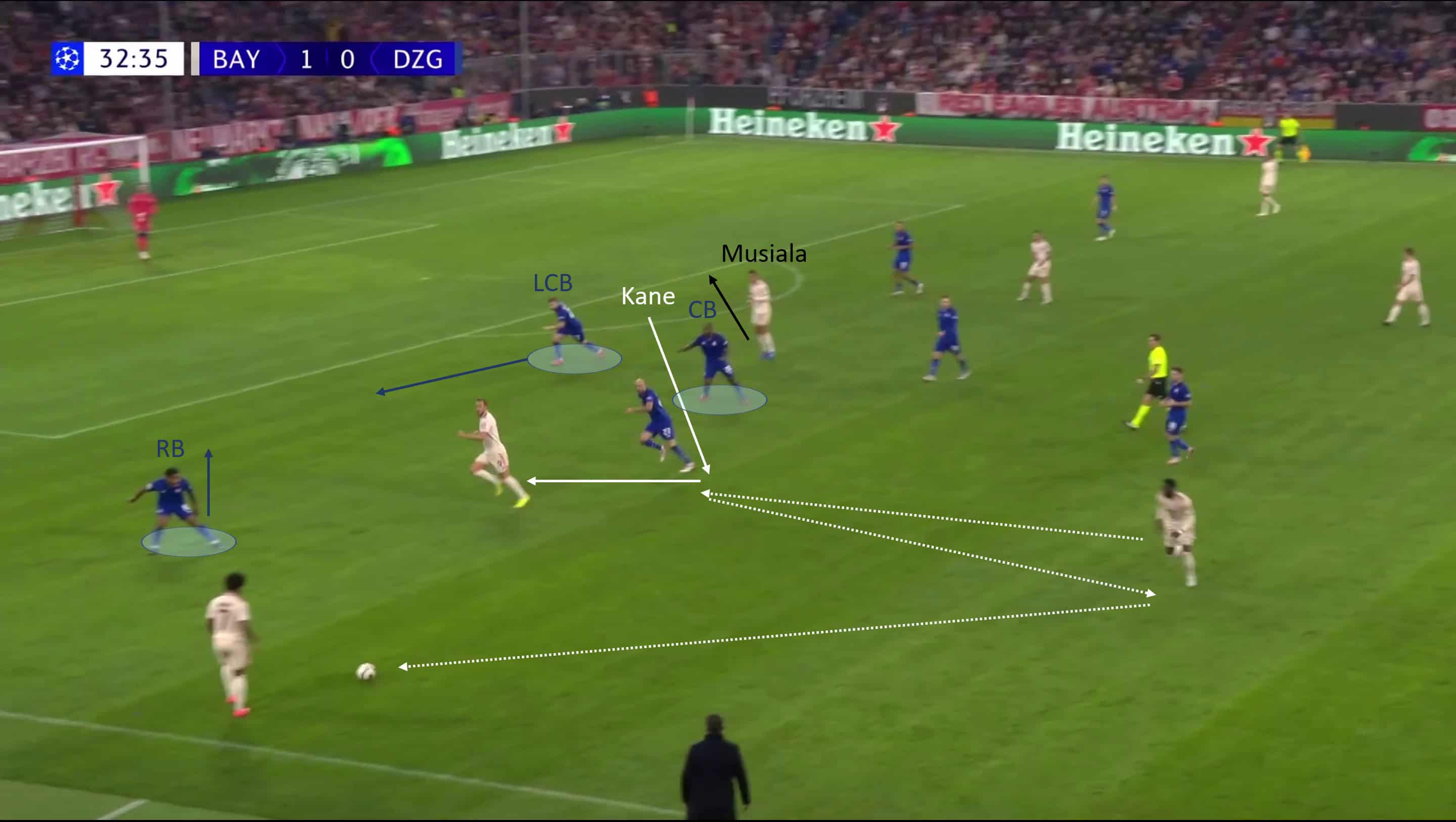
Vincent Company’s offensive tactics were once again on display as his Bayern men showed yet another tactical masterclass in attack.
The 2-0 goal in the 33rd minute demonstrates how to break down a deep-lying opponent through play.
Alphonso Davies dribbles in the half-space towards Zagreb’s right-sided central midfielder while Harry Kane drops to receive the ball, pulling the man-marking central defender from Zagreb’s back three out of the last line.
After a quick layoff to Davies, Kane makes a run into the gap between the full-back and the outer centre-back, managing to occupy an incredible three players in the process.
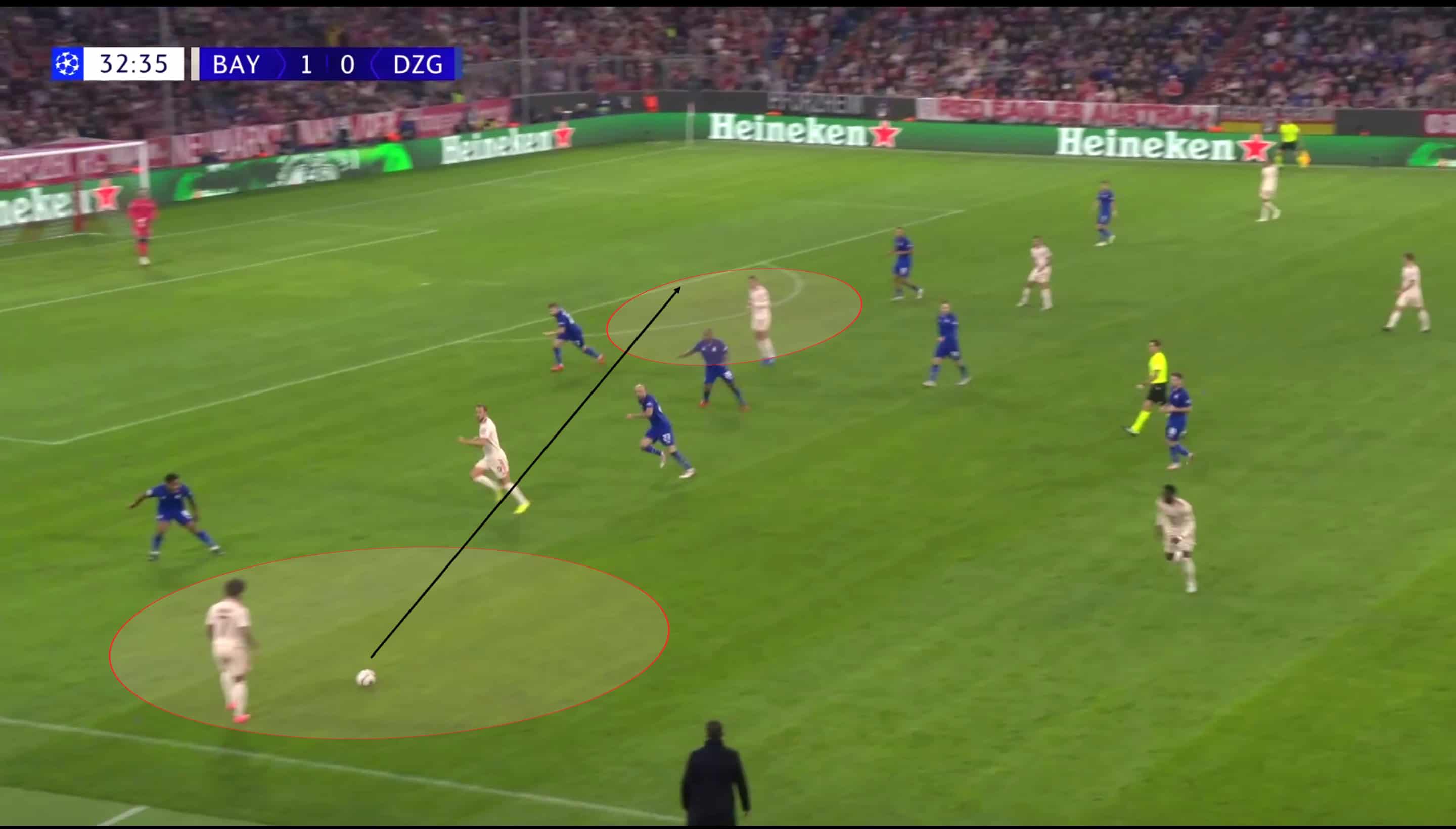
The now free Serge Gnabry on the wing can cross to Jamal Musiala, who makes a run into the newly opened space on the last line.
Musiala lays it off to Raphaël Guerrero, who ultimately scores.
Noteworthy: Kane manages to pull the central defender out, giving the number 10, Musiala, space in behind.
In addition, Kane occupies Gnabry’s defender, enabling Gnabry to cross to Musiala.
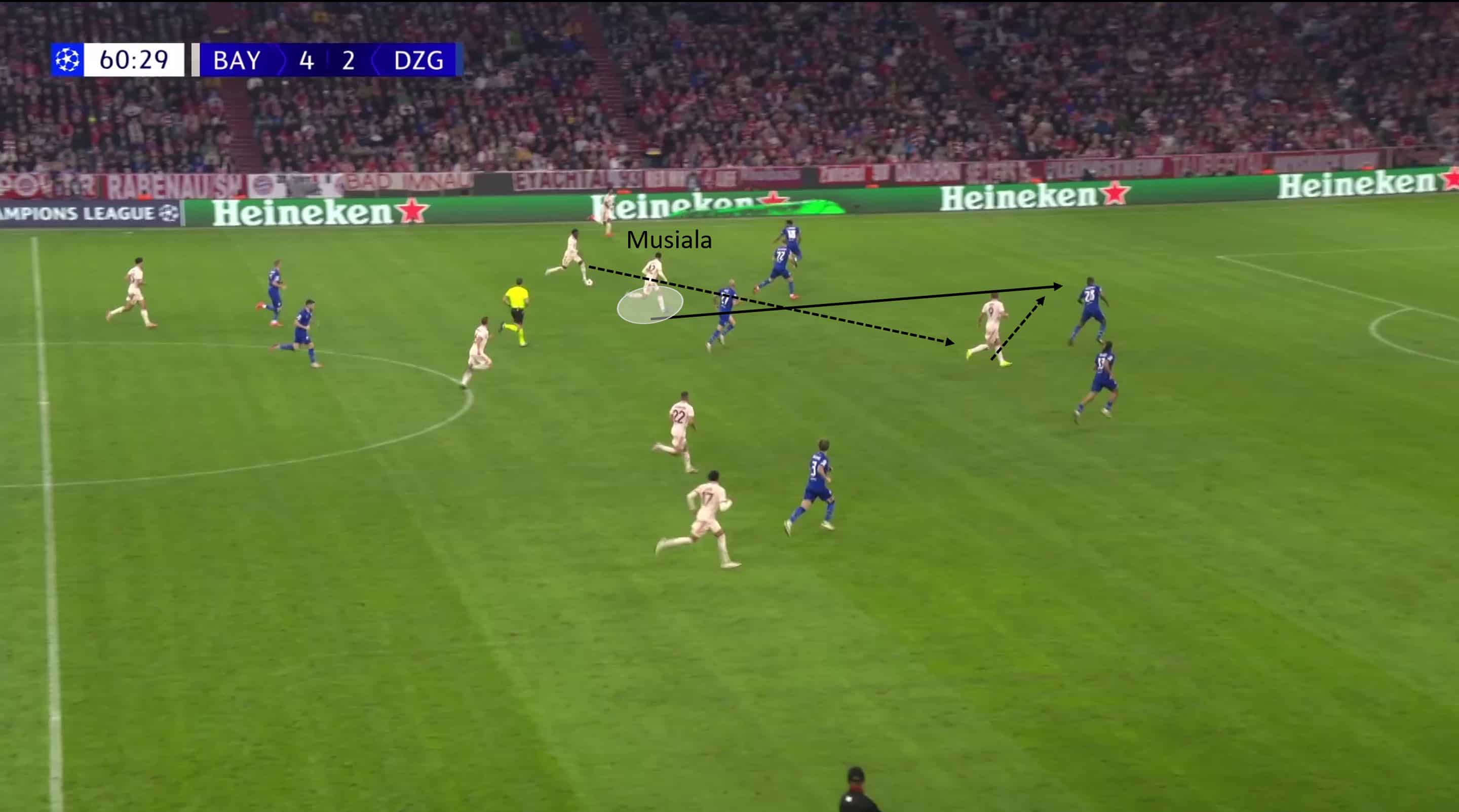
The goal to make it 5-2 comes after bypassing the opponent’s attacking press.
Davies again dribbles down the half-space, engaging the right centre-back, who is forced to step out.
Kane occupies the central defender, drops deep, and lets the ball bounce into the now-unguarded space behind the defence.
Remarkable to watch is the acceleration in Musiala’s deep run at the moment Davies passes to Kane.
In both the 2-0 and the 5-2, it’s clear how Munich managed to occupy and lure all the defenders, allowing Musiala to make a run from deep into the vacated space.
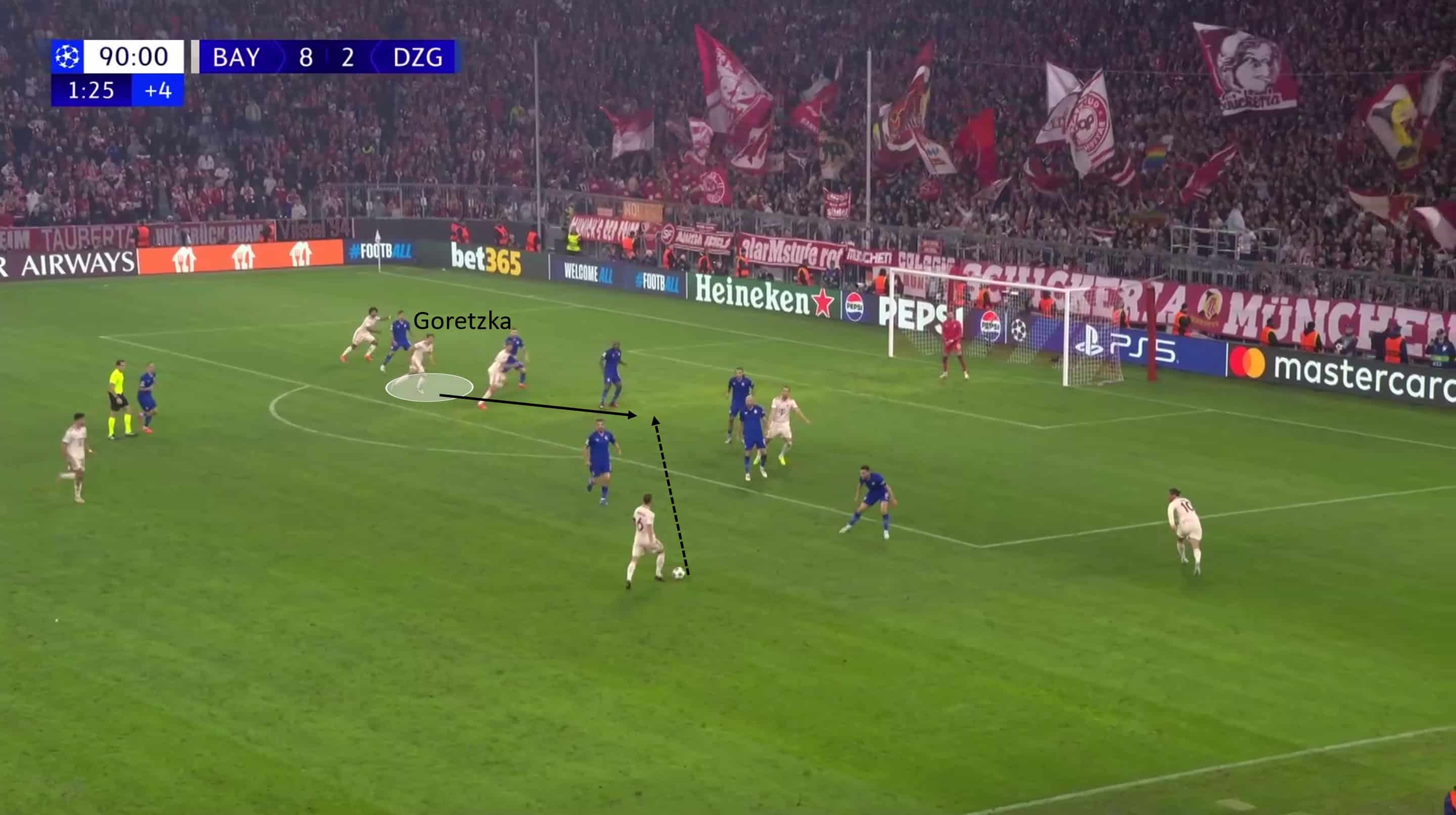
For the sake of completeness, the 9-2 should also be mentioned.
It’s a classic Leon Goretzka goal: Joshua Kimmich crosses from half-space, the box is tied up in man-to-man marking, and Goretzka overloads the penalty area from deep.
With his power and stature, he becomes unmarkable in the aerial duel.
Sparta Prague 3-0 Red Bull Salzburg
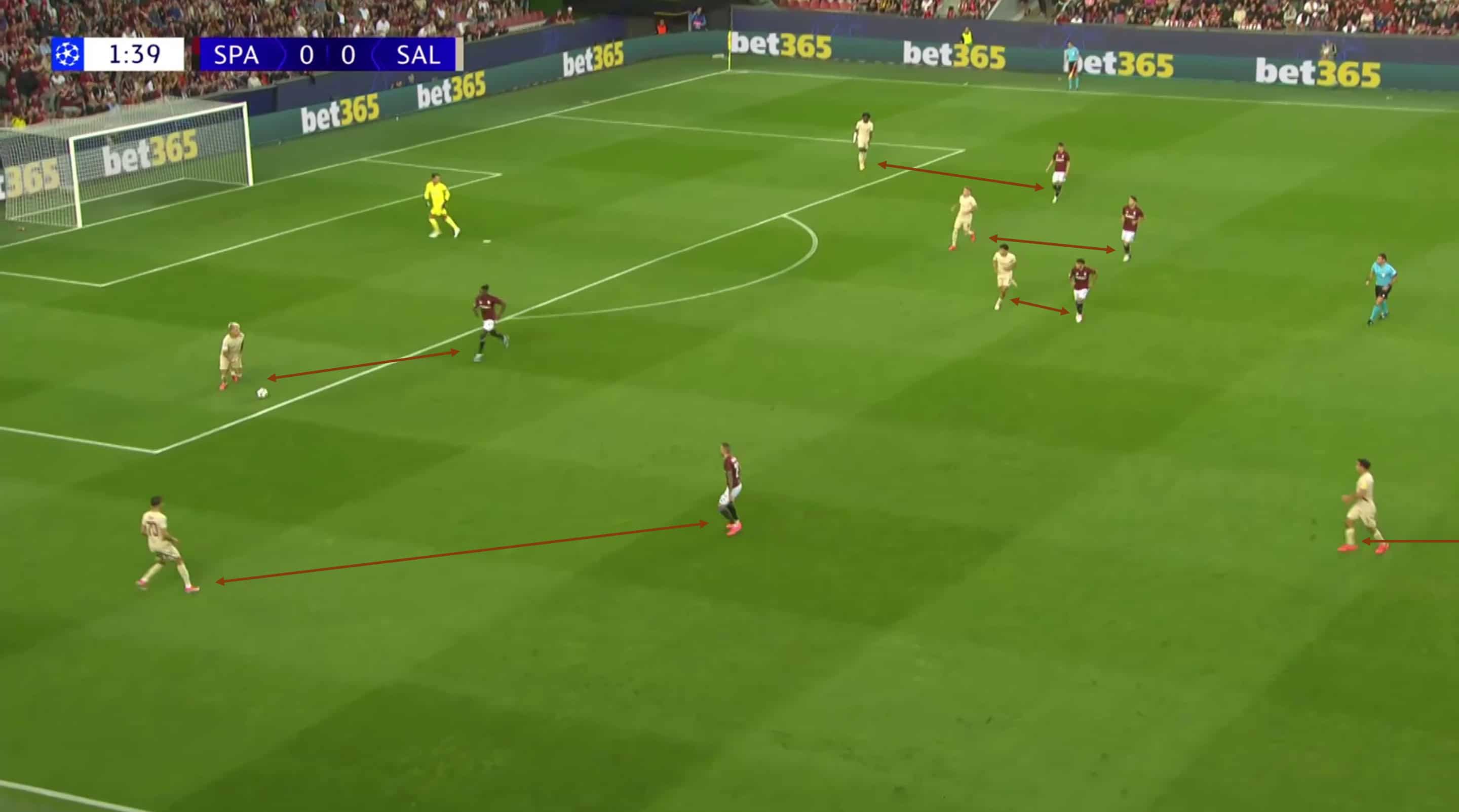
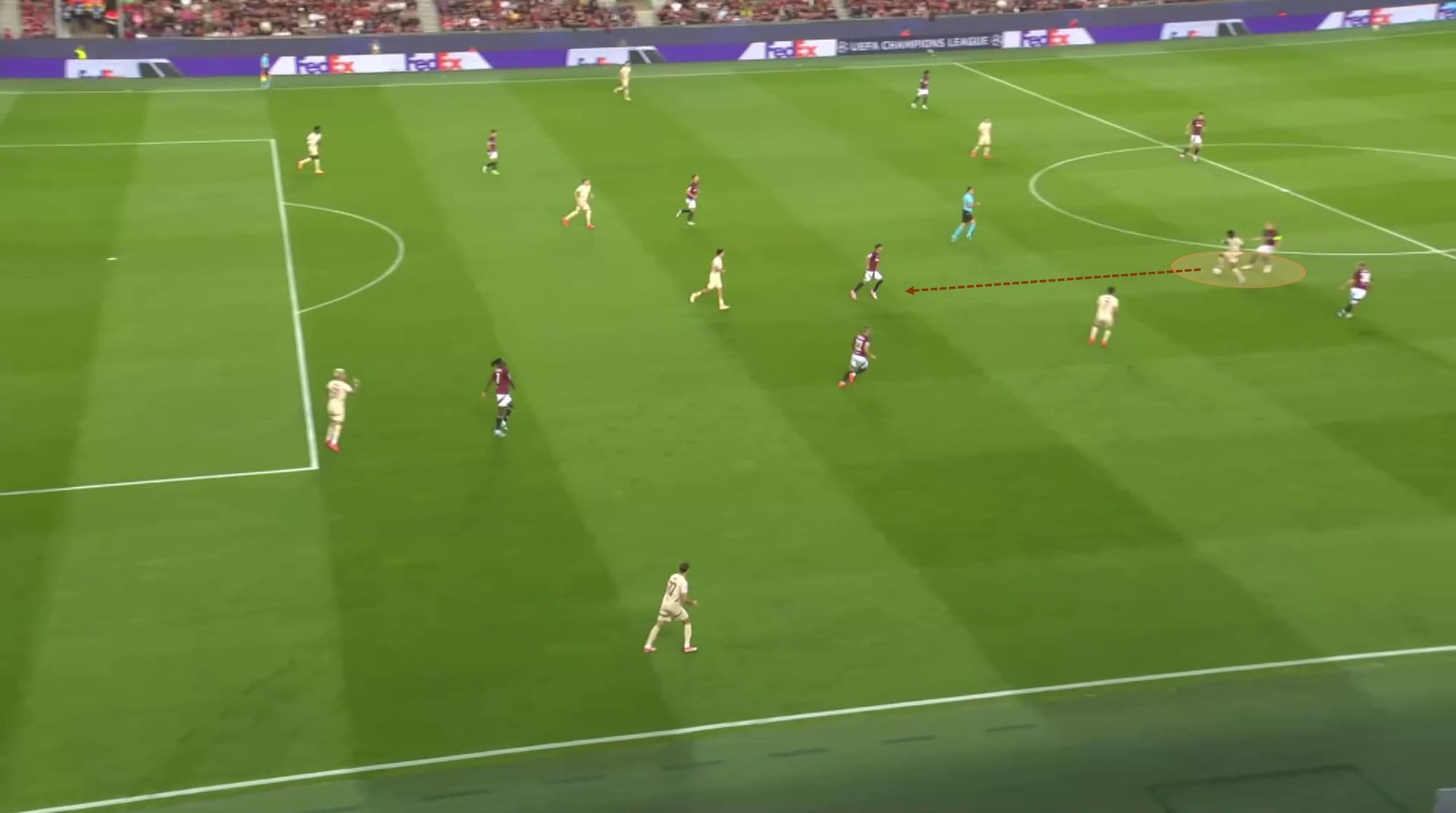
Prague’s man-oriented attacking press led to the 1-0 in just the second minute after the advancing centre-back recovered a ball.
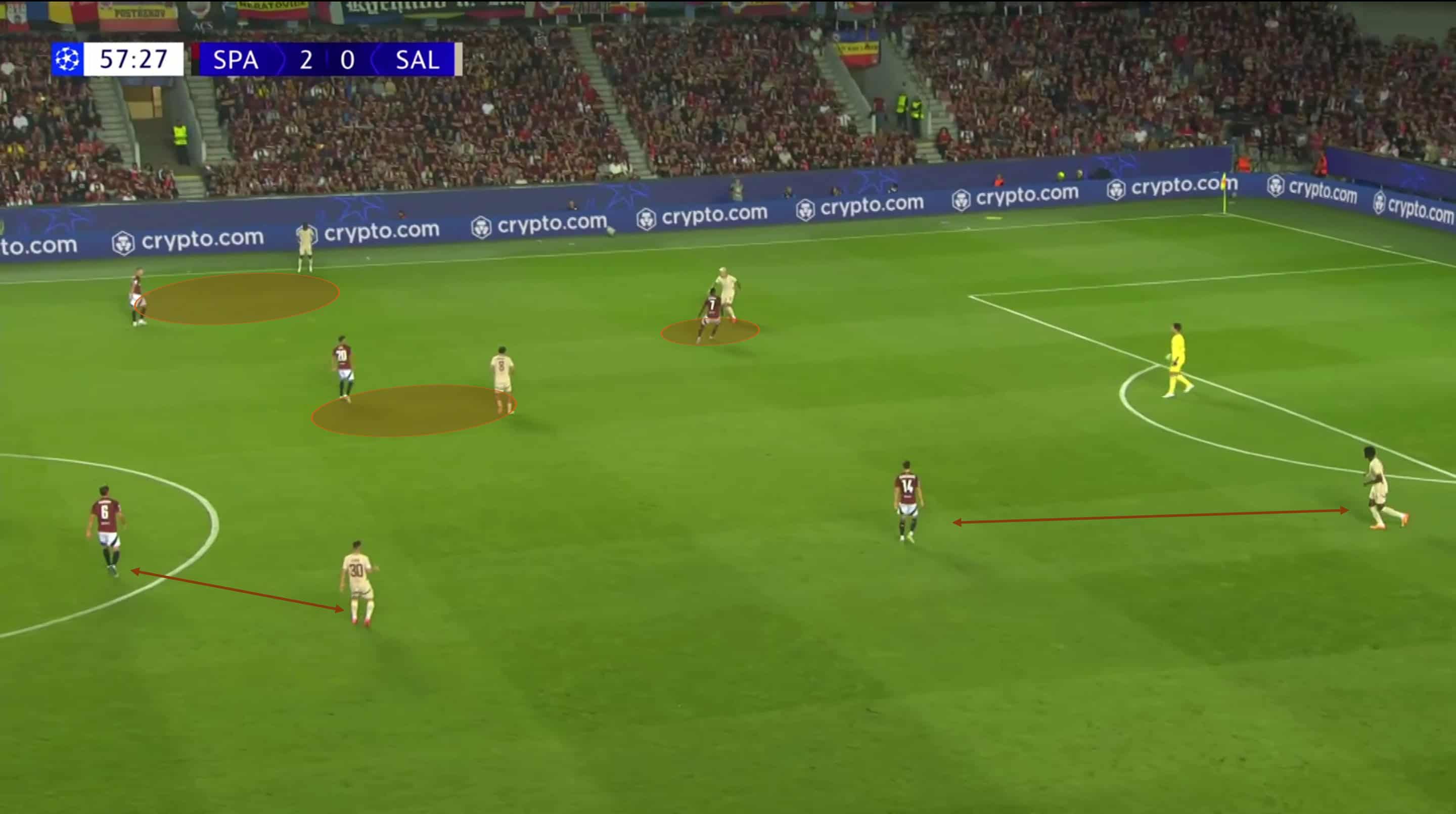
The 3-0 in the 58th minute also comes from a ball recovery due to the very aggressive man-oriented attacking press.
Club Brugge 0-3 Borussia Dortmund
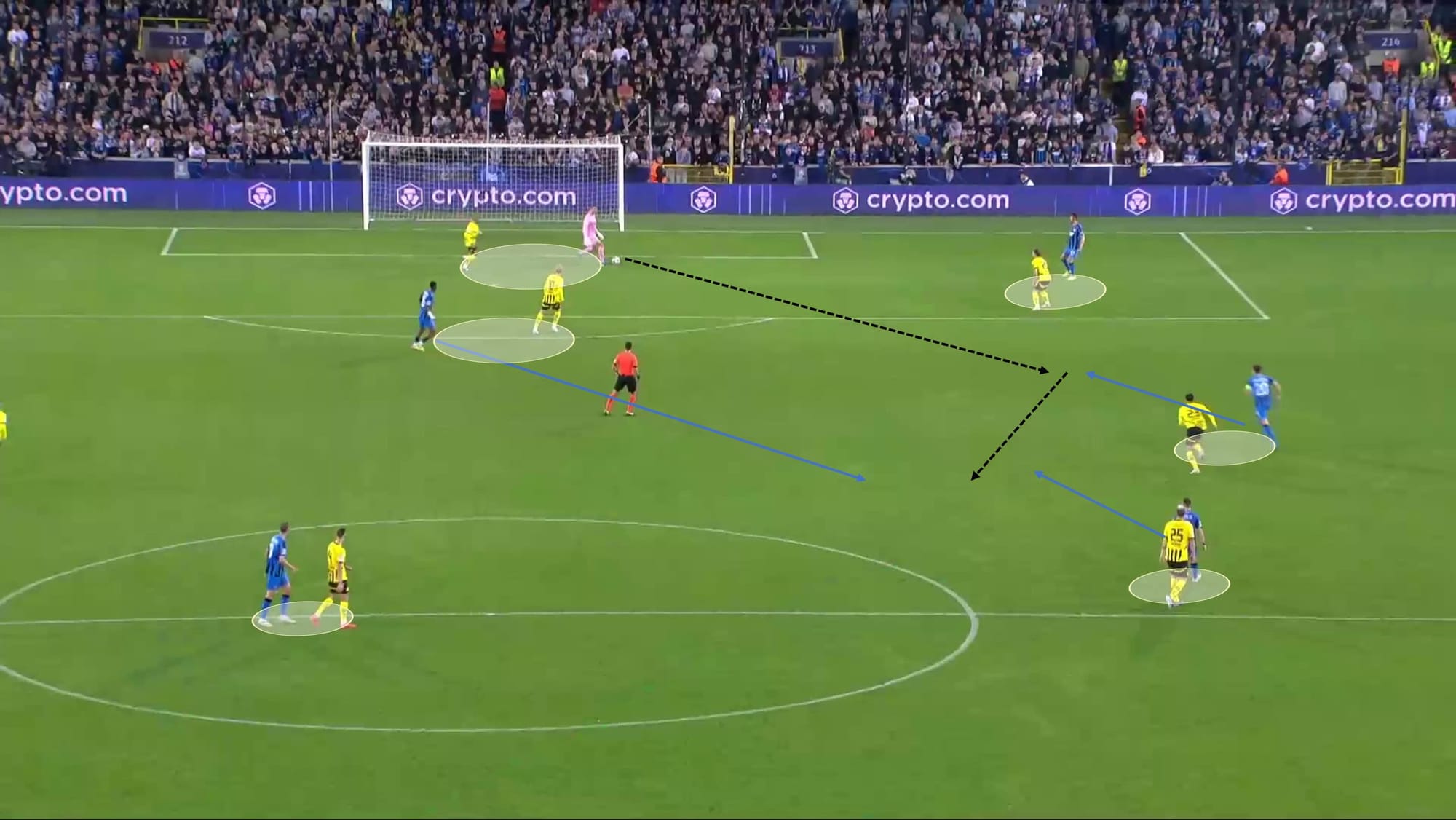
Club Brugge demonstrate impressively in the 24th minute how to bypass Borussia Dortmund’s attacking press.
The left-sided ‘number 8’ drops deep, the ‘number 6’ makes a counter-movement, and the striker also drops to receive, followed by a pass to the deep-running right-sided ‘number 8’.
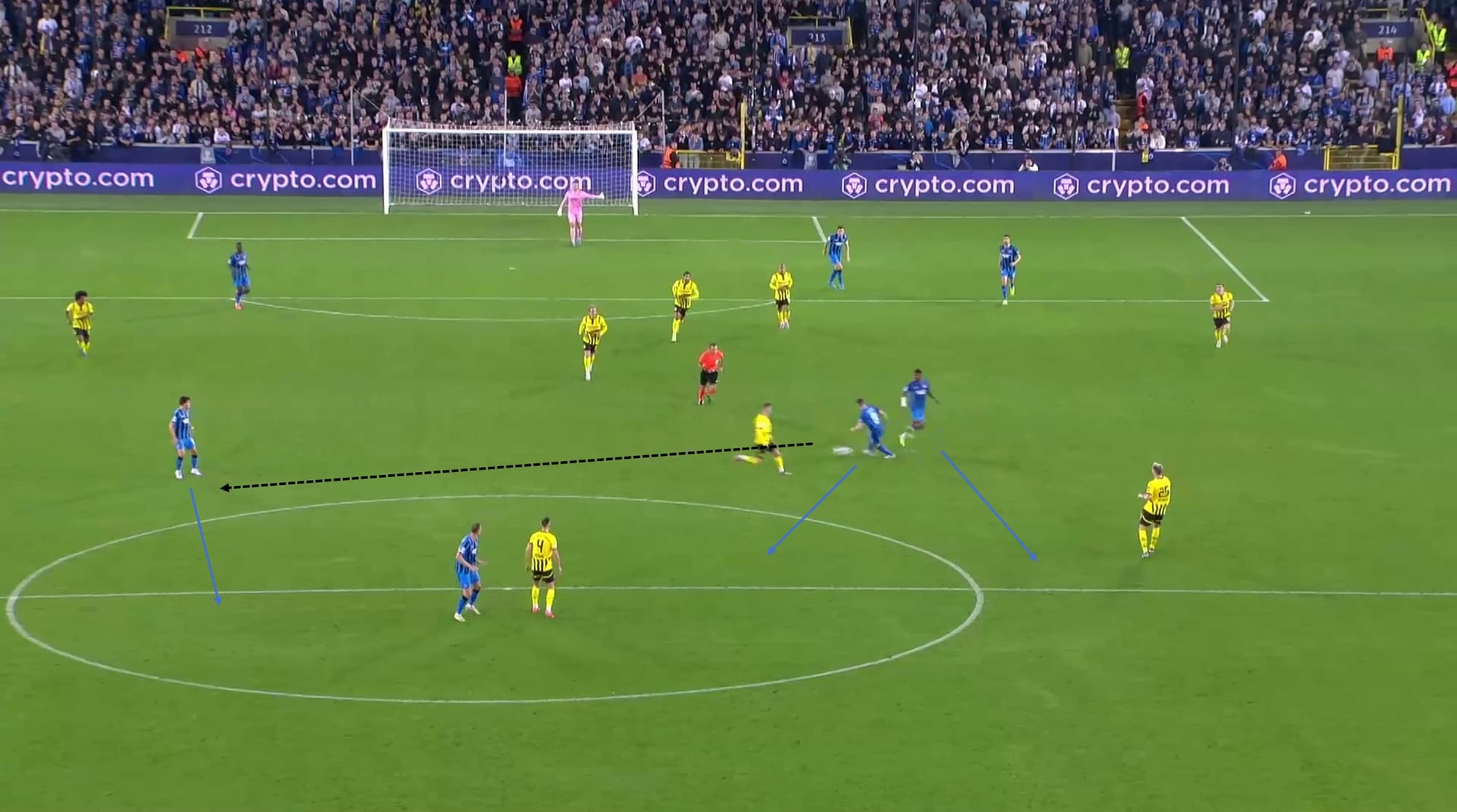
When building up against high, man-oriented pressing: spread the play wide, use opposing movements behind the opponent, advance to the next line, and take advantage of the overload…
Man City 0-0 Inter Milan
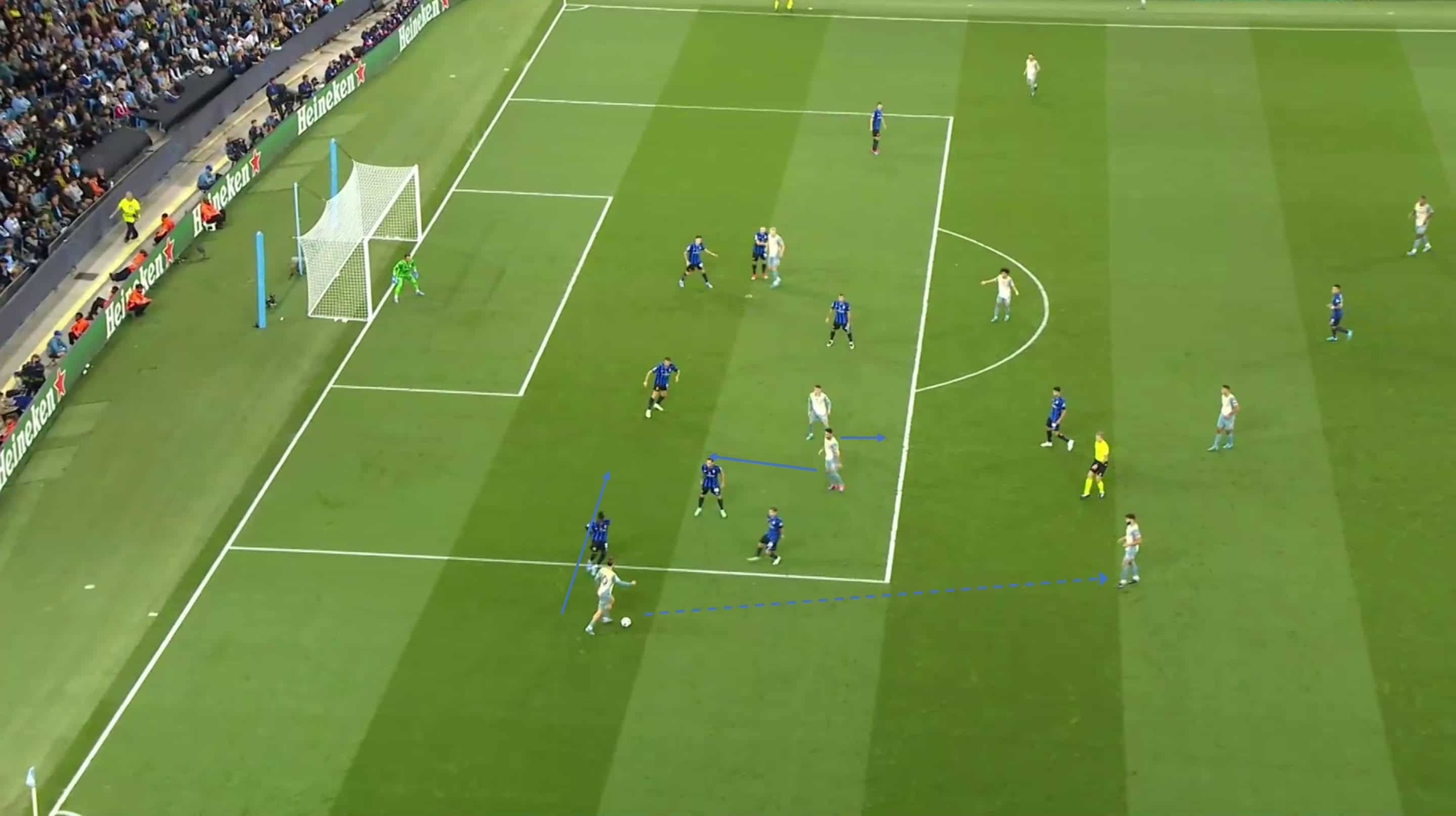
Manchester City push the opponent deep, with Inter Milan content to sit back.
In the 68th minute, we see an outstanding play from Manchester City in a very tight space.
The typical Pep Guardiola formation and zone occupation are to create 1v1s / overloads out wide, make runs in behind for cutback crosses or, if defended, find space for a shot from the edge of the box.
Counter-movements are used quite a bit and movements vary depending on game state and opponent.
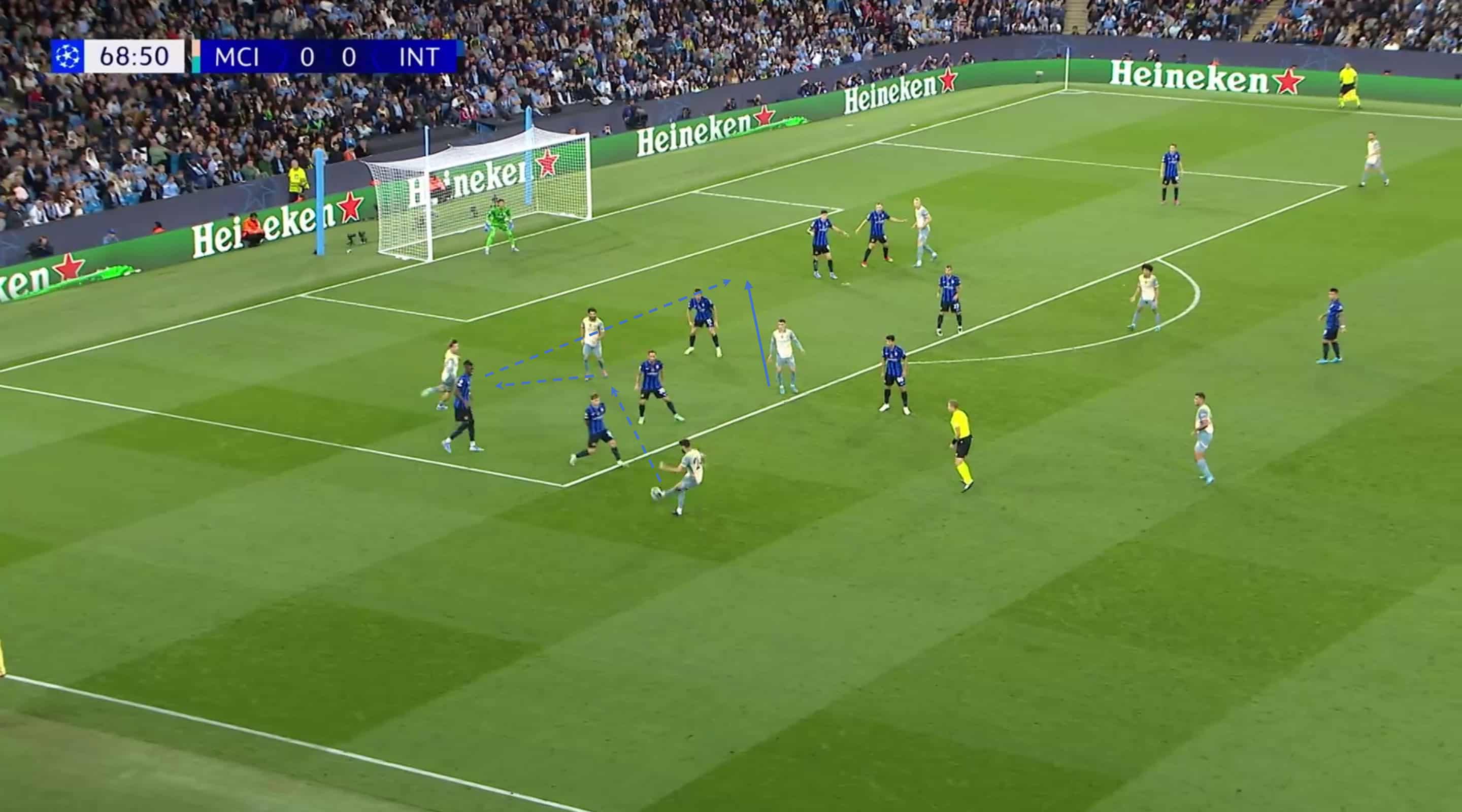
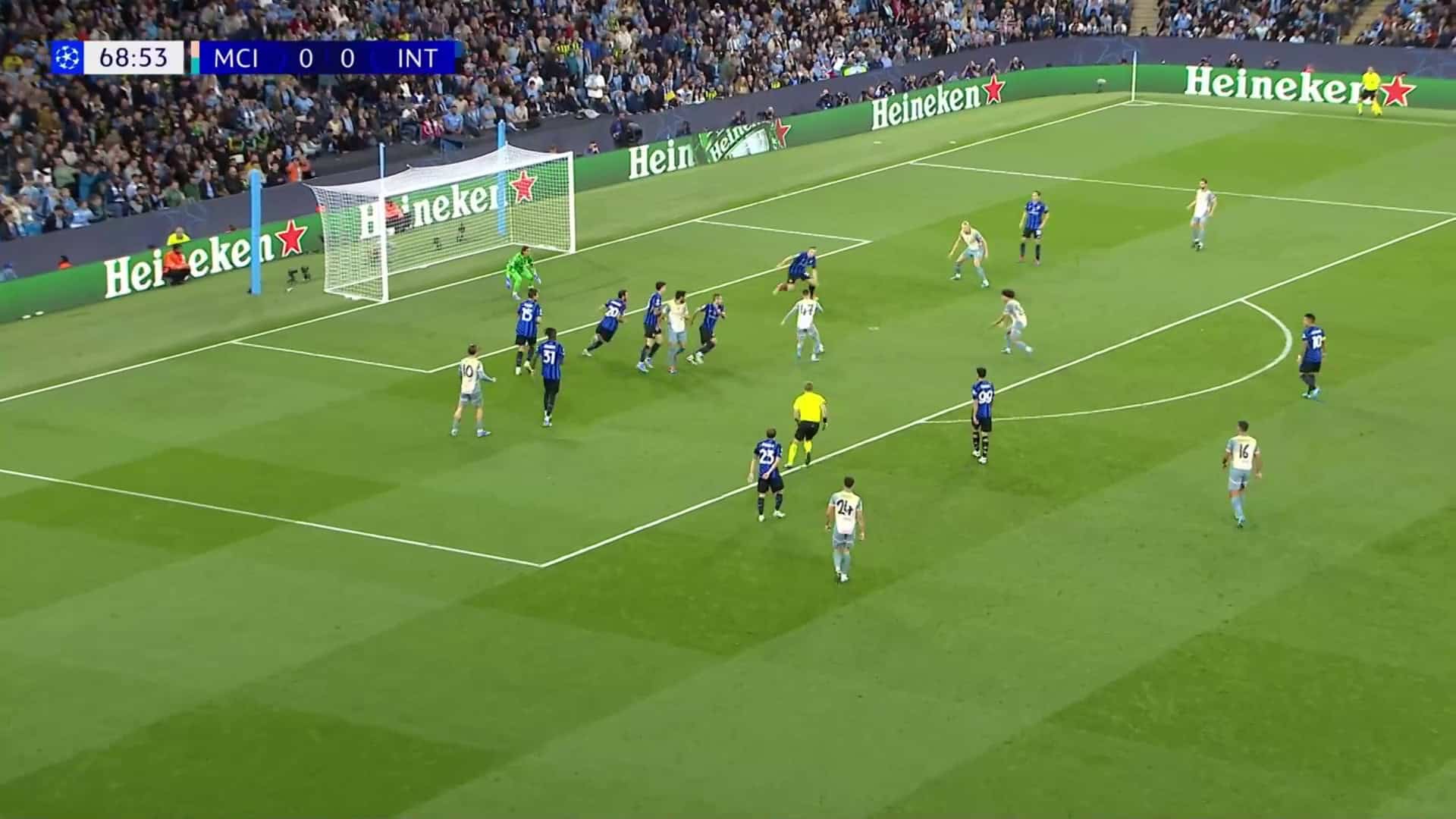
The formation is also perfectly suited to win the ball back immediately through counterpressing, creating an overload near the ball and behind it in tight spaces.
Feyenoord 0-4 Bayer Leverkusen
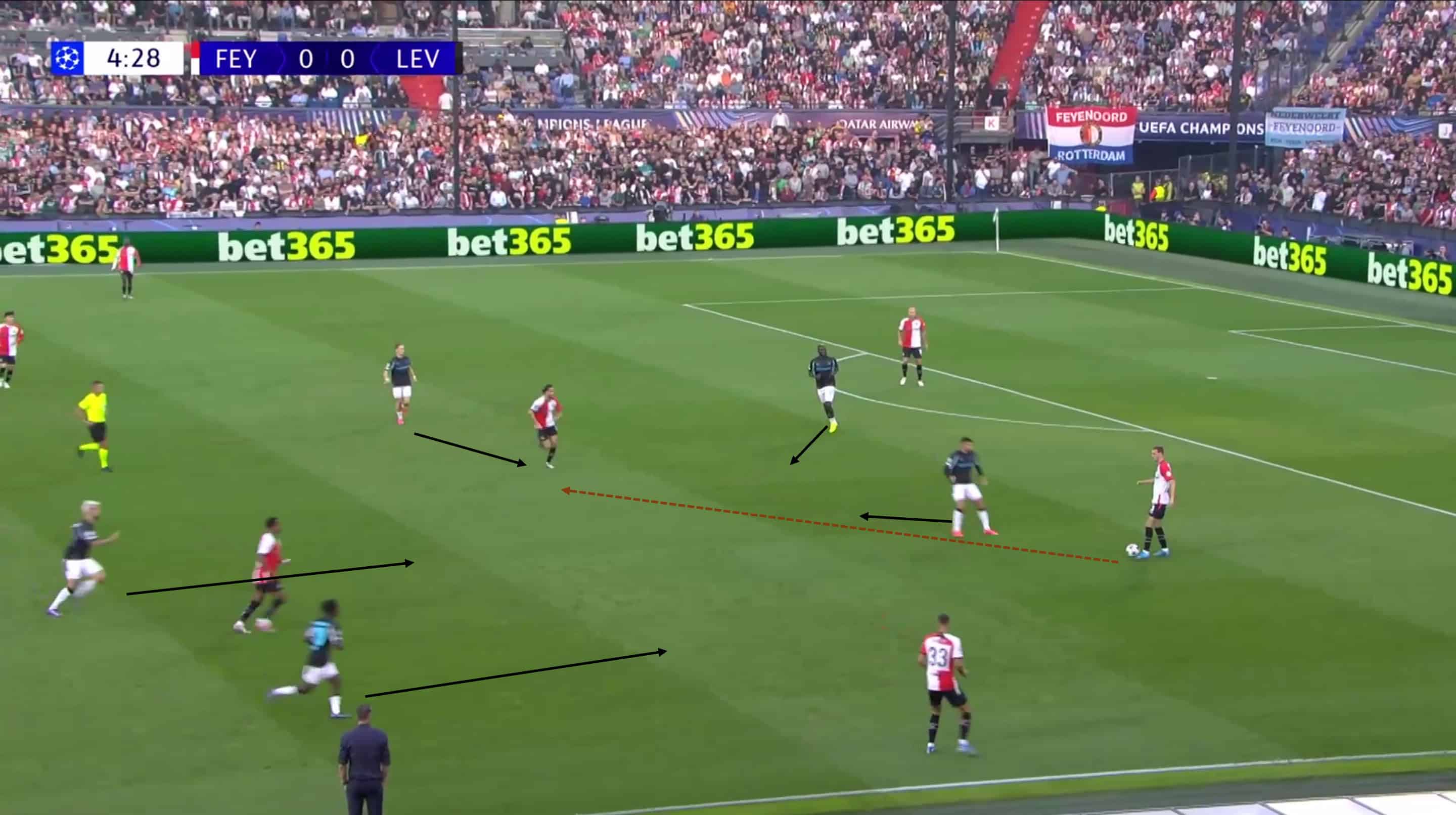
Leverkusen’s space-oriented attacking press leads to a ball recovery in the centre.
By shifting towards the ball, they create numerical superiority in that area.
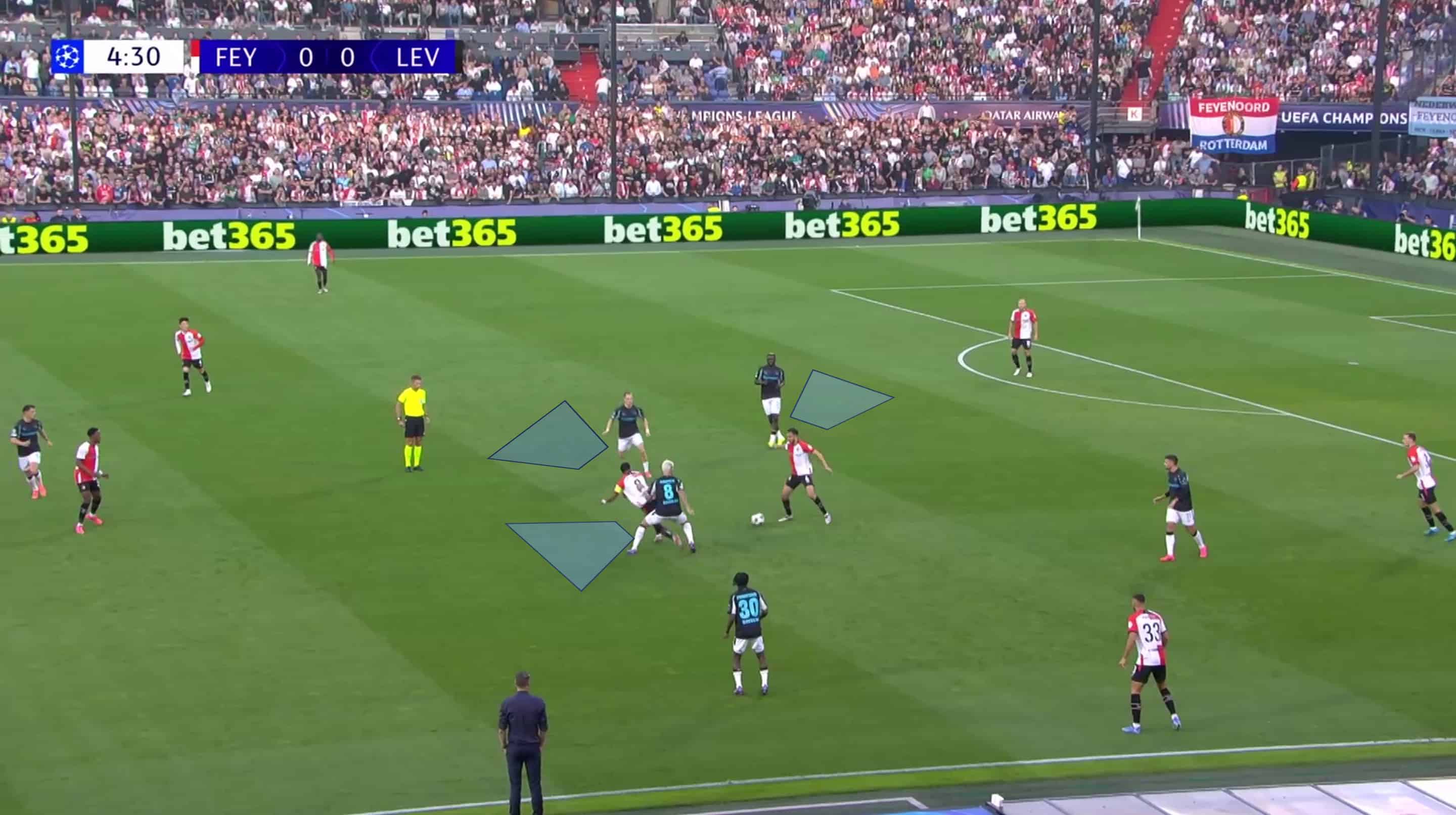
Close pressing on the opponent in possession generates cover shadows, cutting off potential passing options.
Following the ball recovery, a 3v2 situation arises, and Wirtz opens the scoring.
Atlético Madrid 2-1 RB Leipzig
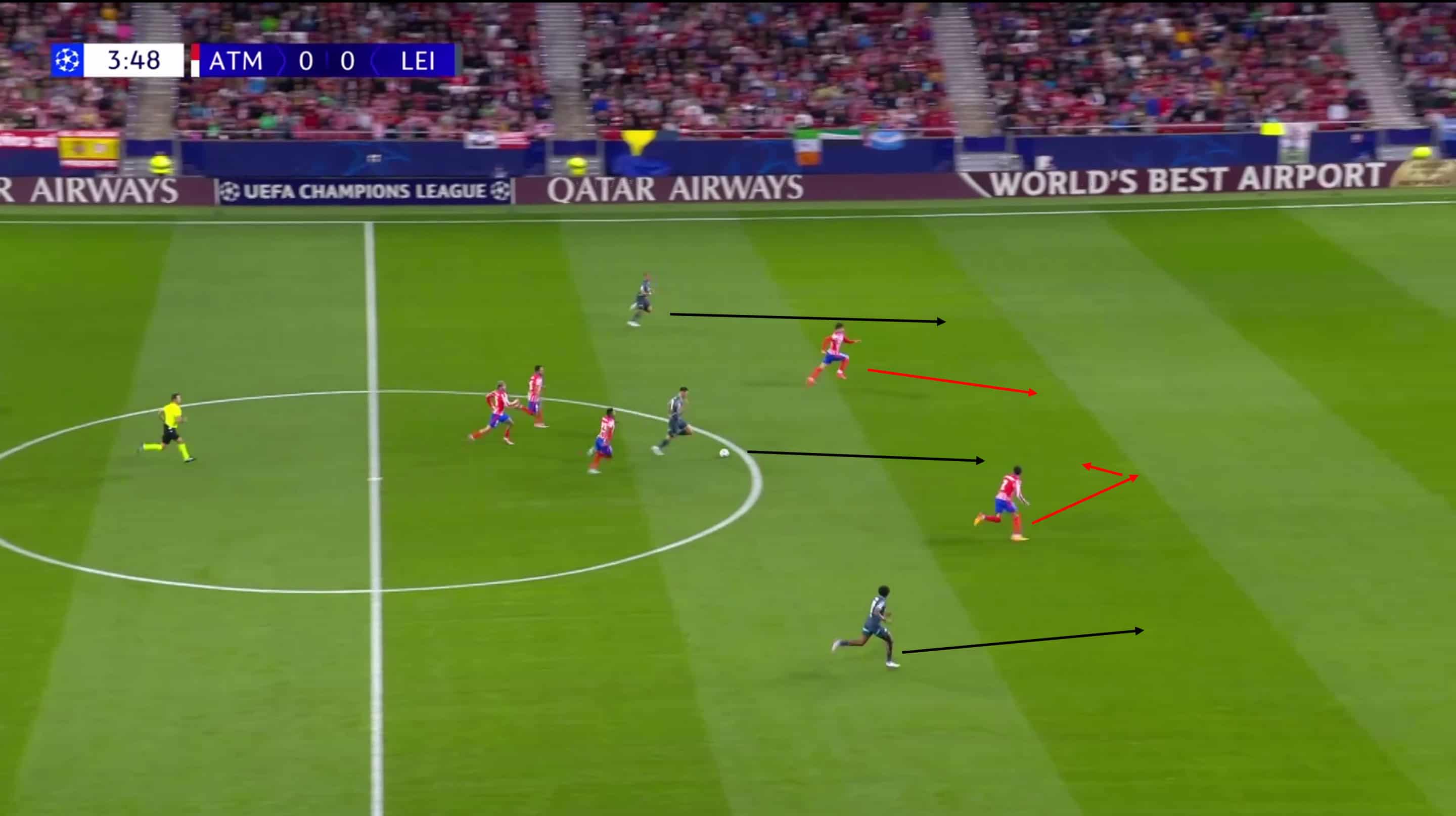
Leipzig’s first goal comes from a transition situation.
Leipzig execute the 3v2 principles brilliantly: exploiting their numerical advantage in the centre, seeking depth on the wings, and dribbling towards opponents to engage and occupy them.
This forces the defenders to choose between pressing the ball or blocking the passing lanes.
Monaco 2-1 Barcelona
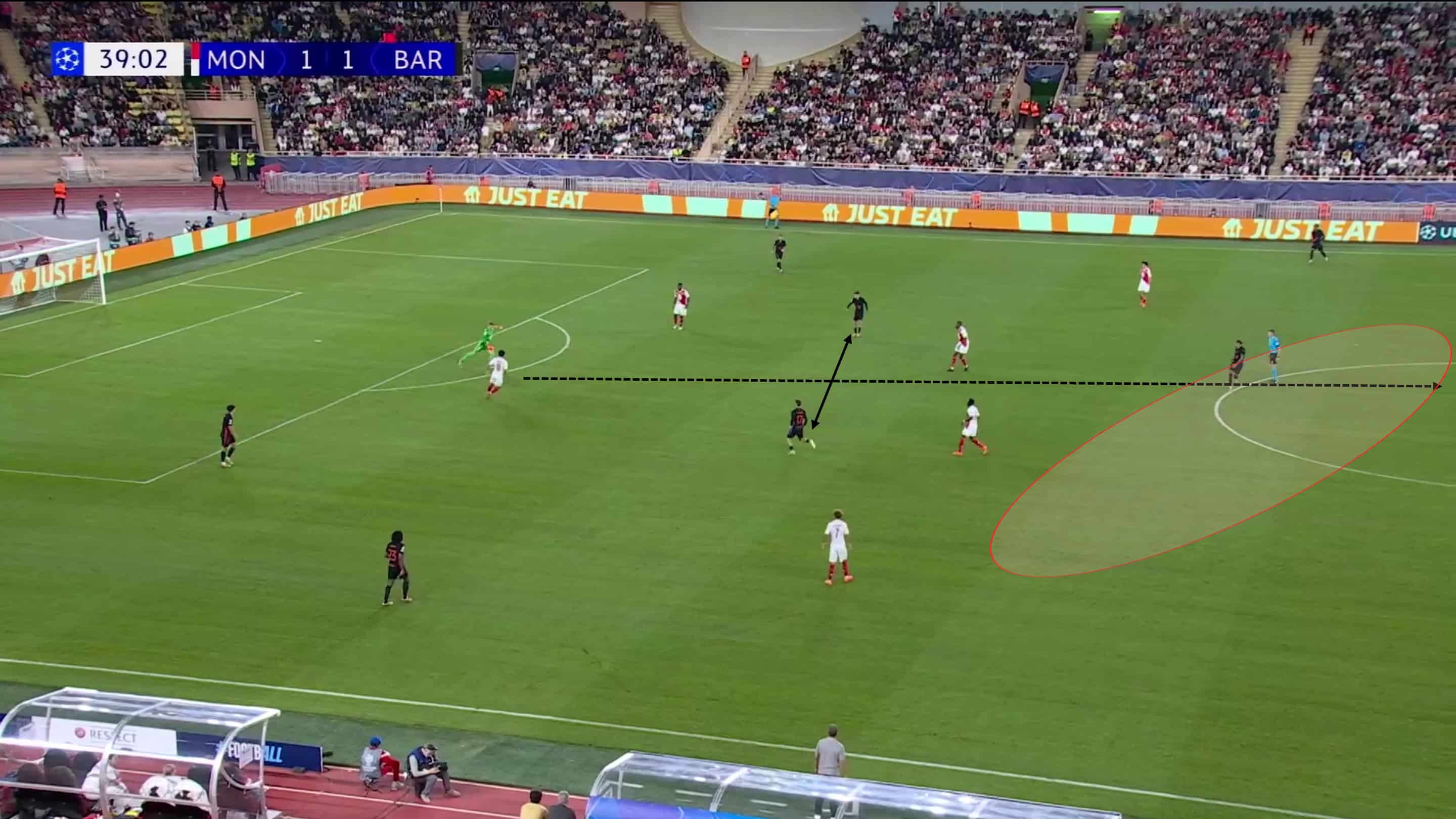
Building up while outnumbered against a high-pressing opponent: Barcelona use a direct ‘wall pass’ strategy and manage to maintain possession.
The two centre-backs and two defensive midfielders position themselves very wide to create space in the centre.
The goal is to use Robert Lewandowski as a wall player and passing option.
Marc-André Ter Stegen’s low pass to Lewandowski bypasses six opponents, allowing Barcelona to dribble towards the last defensive line.
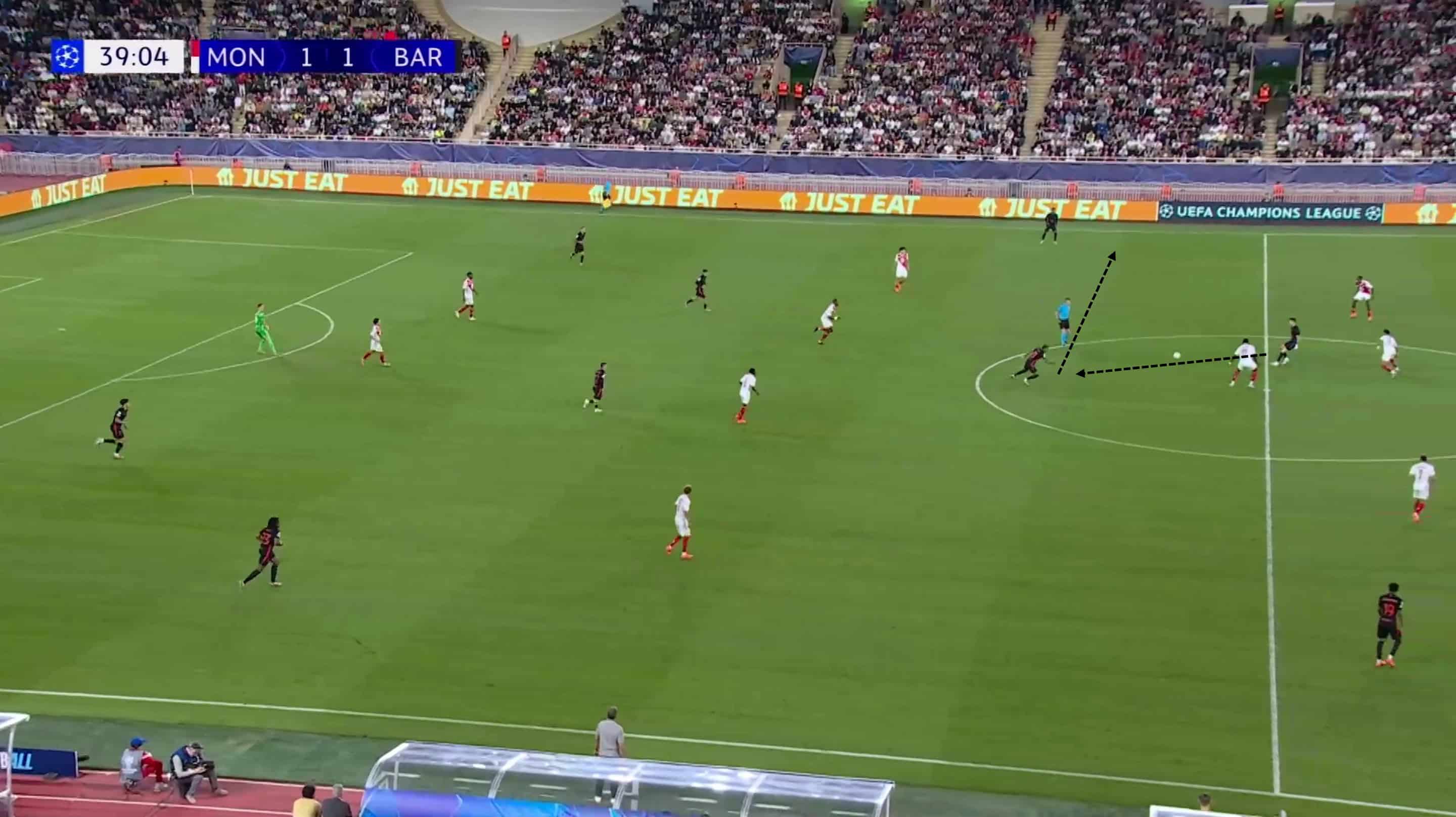
From Monaco’s perspective, adding another player in the centre who is oriented to cover space would have been beneficial in closing this gap.
A space-oriented attacking press in a 4-3-3 shape, steering the opponent to one side, would have the added advantage of immediately pressing the goalkeeper with numerical superiority.
The +1 overload on the last line could be dissolved to apply even more pressure.
Conclusion
To conclude, we’ve highlighted some highly impressive plays from match week 1 of the UEFA Champions League.
This scout report shares insight for fans and coaches alike on what’s worked well so far in the 2024/25 UEFA Champions League, what to watch out for as the tournament progresses, and current tactical trends at the elite level.






Comments